Confucianism Guides d'étude, Notes de cours & Résumés
Vous recherchez les meilleurs guides d'étude, notes d'étude et résumés sur Confucianism ? Sur cette page, vous trouverez 486 documents pour vous aider à réviser pour Confucianism.
Page 2 sur 486 résultats
Trier par
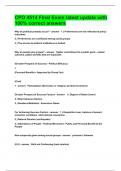
-
CPO 4514 Final Exam latest update with 100% correct answers
- Examen • 7 pages • 2024
-
- €13,82
- + en savoir plus
Why do political protests occur? 1.) Preferences are not reflected to policy outcomes. 2.) Preferences are conflicted among social groups. 3.) The access to political institutions is limited. Why do people join groups? Higher commitment to a public good - valued outcome: public benefits that are expected. (Greater Prospect of Success - Political Efficacy) + (Personal Benefits + Appraisal by Group Fan) - (Cost) = Participation (Economic or religious protest movement) ...

-
GEOG 2303 Test 4 Questions and Answers
- Examen • 33 pages • 2024
-
Disponible en pack
-
- €11,79
- + en savoir plus
Which country has operated as an independent country since World War II, but is claimed by China as a province? Ans- Taiwan Which two East Asian countries have wet climates year-round because of their proximity to the sea? Ans- Korea and Japan Two of China's largest rivers, the Chan Jiang and Huange He, are fed by Ans- glaciers on the plateau of Tibet Which of the following is NOT true of dam projects in China Ans- Chinese dam projects have compensated landholders for the appropria...

-
Religions East And West Final Exam Questions With Verified Solutions Graded A+
- Examen • 20 pages • 2024
-
- €11,97
- + en savoir plus
Religions East And West Final Exam Questions With Verified Solutions Graded A+ D. Islam and Hinduism Sikhism was influenced by _________ A. Jainism and Hinduism B. Confucianism and Islam C. Buddhism and Hinduism D. Islam and Hinduism D. learner Sikh means _________ A. the enlightened one B. master C. god D. learner B. Guru Gobind Singh, the tenth Guru It was __________ who established the Sikh military community and created the Khalsa ritual. A. Guru Nanak B. Guru Gobind Singh...
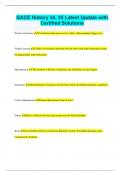
-
GACE History 34, 35 Latest Update with Certified Solutions
- Examen • 12 pages • 2024
-
- €8,29
- + en savoir plus
GACE History 34, 35 Latest Update with Certified Solutions fluvial civilizations Civilizations that arose in river valleys (Mesopotamia, Egypt, etc.) Fertile Crescent Cradle of civilization from the Persian Gulf to the Sinai Peninsula (coined by Egyptologist James Breasted) Mesopotamia The location of the first civilization, the Akkadians, led by Sargon Sumerians Mesopotamian civilization. Invented the wheel, developed irrigation, cuneiform. Code of Hammurabi Famous Babylonian...
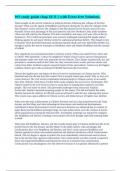
-
WS study guide chap 10/11 || with Error-free Solutions.
- Examen • 5 pages • 2024
-
- €9,76
- + en savoir plus
What brought on the several centuries of political division following the collapse of the Han dynasty? What was the appeal of Buddhism and Daoism during the era after the collapse of the Han dynasty? correct answers The collapse of the Han dynasty led to division and civil wars. Nomadic forces took advantage of this and started to rule over Northern China while Southern China was still ruled by the Chinese. This led to instability and many civil wars. (Era of the six dynasties) // The Confucian ...

Peur de manquer quelque chose ? Alors non !
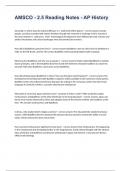
-
AMSCO - 2.5 Reading Notes - AP History questions with verified solutions
- Examen • 6 pages • 2024
-
Disponible en pack
-
- €11,97
- + en savoir plus
AMSCO - 2.5 Reading Notes - AP HistoryGenerally, in which ways did cultural diffusion in c. effect places? - correct answers Goods, people, and ideas traveled with relative freedom through the networks of exchange in Afro- Eurasia in the years between c. 1200 and c. 1450. Technological developments were diffused by trade. Literary and artistic interactions and cultural exchanges were documented by travelers. How did it (Buddhism) spread to China? - correct answers Buddhism came to China from...
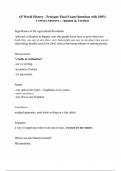
-
AP World History - Prologue Final Exam Questions with 100% Correct Answers | Updated & Verified
- Examen • 8 pages • 2024
-
Disponible en pack
-
- €11,06
- + en savoir plus
Significance of the Agricultural Revolution -allowed civilization to happen. now that people know how to grow their own food, they can stay in one place. now that people can stay in one place they can do other things besides search for food. such as becoming artisans or making pottery. Mesopotamia "cradle of civilization" -see 1st writing. -invention of wheel. -1st agriculture. Sumer -city state in the Tigris + Euphrates river system. -used cuneiform. -was first to use irrigation. Cun...
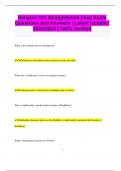
-
Religion 101 Straighterline Final Exam Questions and Answers | Latest Update | 2024/2025 | 100% Verified
- Examen • 20 pages • 2024
-
Disponible en pack
-
- €9,19
- + en savoir plus
Religion 101 Straighterline Final Exam Questions and Answers | Latest Update | 2024/2025 | 100% Verified What is the central tenet of monotheism? Monotheism is the belief in the existence of only one God. What does "polytheism" refer to in religious studies? Polytheism refers to the belief in multiple gods or deities. Who is traditionally considered the founder of Buddhism? Siddhartha Gautama, known as the Buddha, is traditionally considered the founder of Buddhism. W...

-
ABCTE World History questions and answers graded A+
- Examen • 27 pages • 2024
-
Disponible en pack
-
- €19,81
- + en savoir plus
ABCTE World HistoryMaurya Empire 322- 185 BCE - correct answer Indian Empire that was very powerful, ruled by Chandragupta Maurya. They were highly developed and had a strong military. They traded with the Greeks. Their goods were silk, exotic foods, and spices. The main religions were Buddhism and Jainism. They were taken over by Demetrius. After death of Ashoka, Mauryan empire fell. Song Dynasty 960-1279 CE - correct answer Chinese dynasty that was responsible for uniting China. They were...
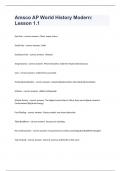
-
Amsco AP World History Modern: Lesson 1.1 questions and answers
- Examen • 4 pages • 2024
-
Disponible en pack
-
- €9,21
- + en savoir plus
Amsco AP World History Modern: Lesson 1.1 East Asia - correct answers China, Japan, Korea South Asia - correct answers India Southeast Asia - correct answers Vietnam Song Dynasty - correct answers Most innovative; made the imperial bureaucracy Coal - correct answers made China successful Protoindustrialization - correct answers industrialization before the Industrial Revolution Artisans - correct answers skilled craftspeople Scholar Gentry - correct answers The high...

Vous demandez-vous pourquoi tant d'étudiants portent de beaux vêtements, ont de l'argent à dépenser et profitent de beaucoup de temps libre ? Eh bien, ils vendent sur Stuvia ! Imaginez que vos notes d'étude soient téléchargées une dizaine de fois pour 15 € pièce. Chaque. Jour. Découvrez tout sur gagner de l'argent sur Stuvia

